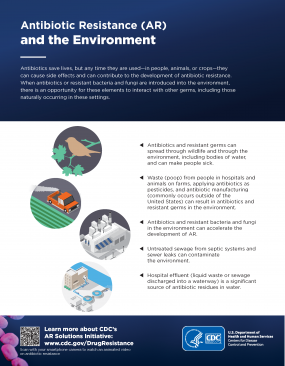Action to Better Understand Antimicrobial Resistance in the Environment
Addressing antimicrobial resistance in the environment (e.g., water, soil) is a key part of using a One Health approach to combat this threat. CDC is interested in addressing how resistance emerges and spreads in the environment, and how it can be a potential risk to human health. Traces of antibiotics and antifungals, germs resistant to them, and genes that cause resistance traits are present and can spread in waterways and soils. However, scientists do not fully understand the risk of resistance in the environment on human health. Learn more about how antimicrobial resistance can spread in water and soil.
CDC implements activities outlined in the U.S. National Action Plan for Combating Antibiotic-Resistant Bacteria, released in 2015 and 2020. These activities are funded through CDC antimicrobial resistance investments, collectively known as CDC’s Antimicrobial Resistance (AR) Solutions Initiative. Through these investments, CDC is transforming how the nation combats antimicrobial resistance.
CDC Activities
Prioritizing Innovative Research
- Enhancing laboratory capacity to detect and report on antimicrobial resistance in the environment
- Establishing and strengthening national tracking systems to respond rapidly to outbreaks, identify emerging pathogens and trends through the Global AR Lab and Response Network
- Identifying and testing new methods for collecting antimicrobial resistance data from the environment, including water and soil
Additional Work in Progress
- Expanding domestic and global capacity to fight antimicrobial resistance in the environment across healthcare, the community, the food supply, and the environment
- Mapping existing antimicrobial resistance ecology across a One Health spectrum and monitoring shifts over time
- Improving international collaboration and capacities for antimicrobial resistance prevention, surveillance, infection control
Examples of CDC Activities in Action
- Released a scientific report in 2018 on the science and research needs to address resistance in the environment
- Studying antimicrobial-resistant bacteria generated during wastewater treatment and evaluating the risk of exposure, colonization, and infection to treatment plant workers; see the below video for the latest on this work
- Supporting investigators to sample surface water for human and agricultural waste and antimicrobial-resistant bacteria
- Investigating the role wastewater plumbing in healthcare facilities play in the survival and spread of antimicrobial-resistant bacteria in patient-care areas
- Studying the effect of azole use (an antifungal drug) on crops to contain the spread of azole-resistant Aspergillus fumigatus
- Investigating how antimicrobial-resistant bacteria from concentrated poultry farms may impact aquatic ecosystems
In 2018, CDC funded the University of South Carolina to measure resistance genes in wastewater and in treatment plant workers at municipal wastewater treatment plants. When the COVID-19 pandemic started, CDC recognized that the research platform could also look for SARS-CoV-2 RNA (which carries genetic information) in wastewater.
